trailer TOYOTA AURIS 2012 (in English) User Guide
[x] Cancel search | Manufacturer: TOYOTA, Model Year: 2012, Model line: AURIS, Model: TOYOTA AURIS 2012Pages: 750, PDF Size: 20.05 MB
Page 255 of 750
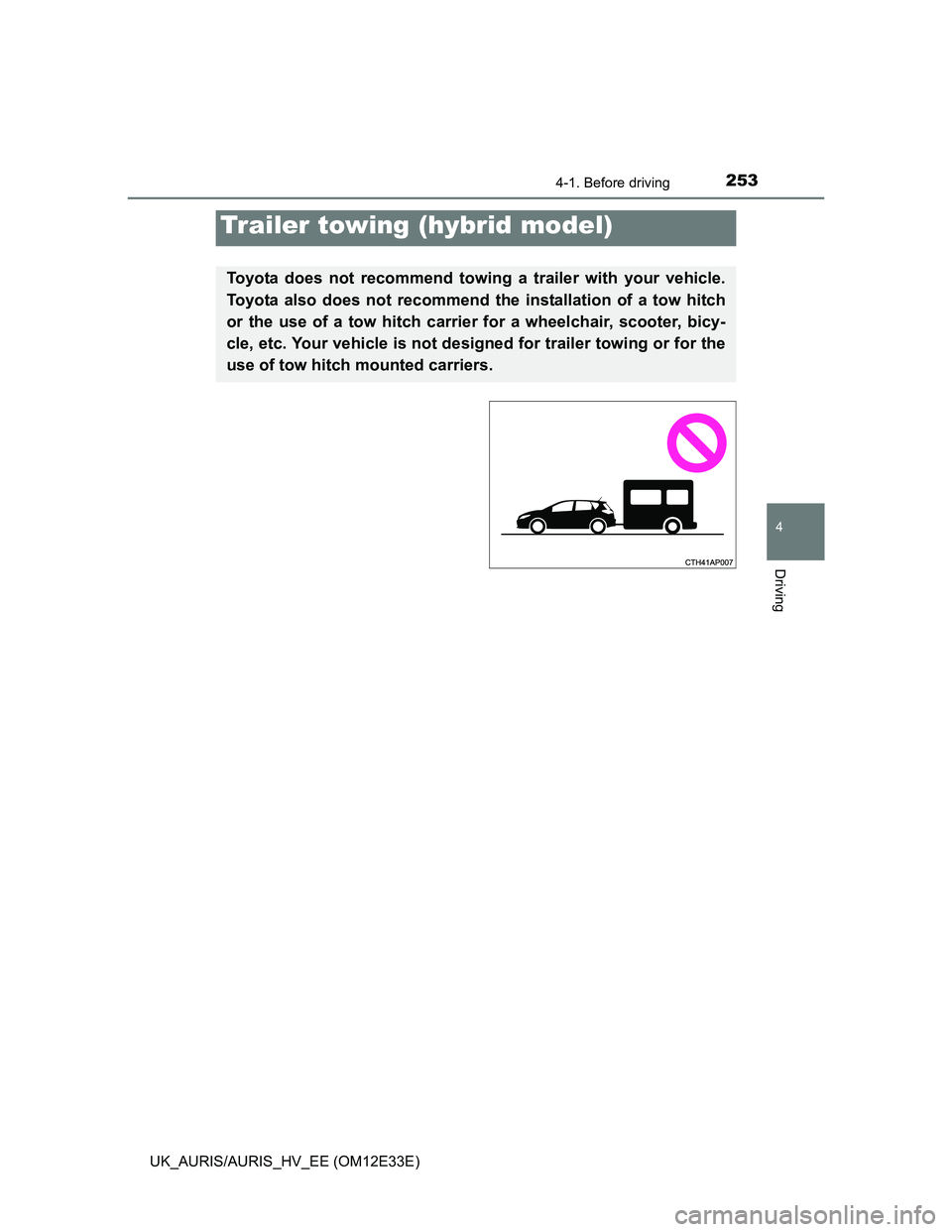
2534-1. Before driving
UK_AURIS/AURIS_HV_EE (OM12E33E)
4
Driving
Trailer towing (hybrid model)
Toyota does not recommend towing a trailer with your vehicle.
Toyota also does not recommend the installation of a tow hitch
or the use of a tow hitch carrier for a wheelchair, scooter, bicy-
cle, etc. Your vehicle is not designed for trailer towing or for the
use of tow hitch mounted carriers.
Page 310 of 750
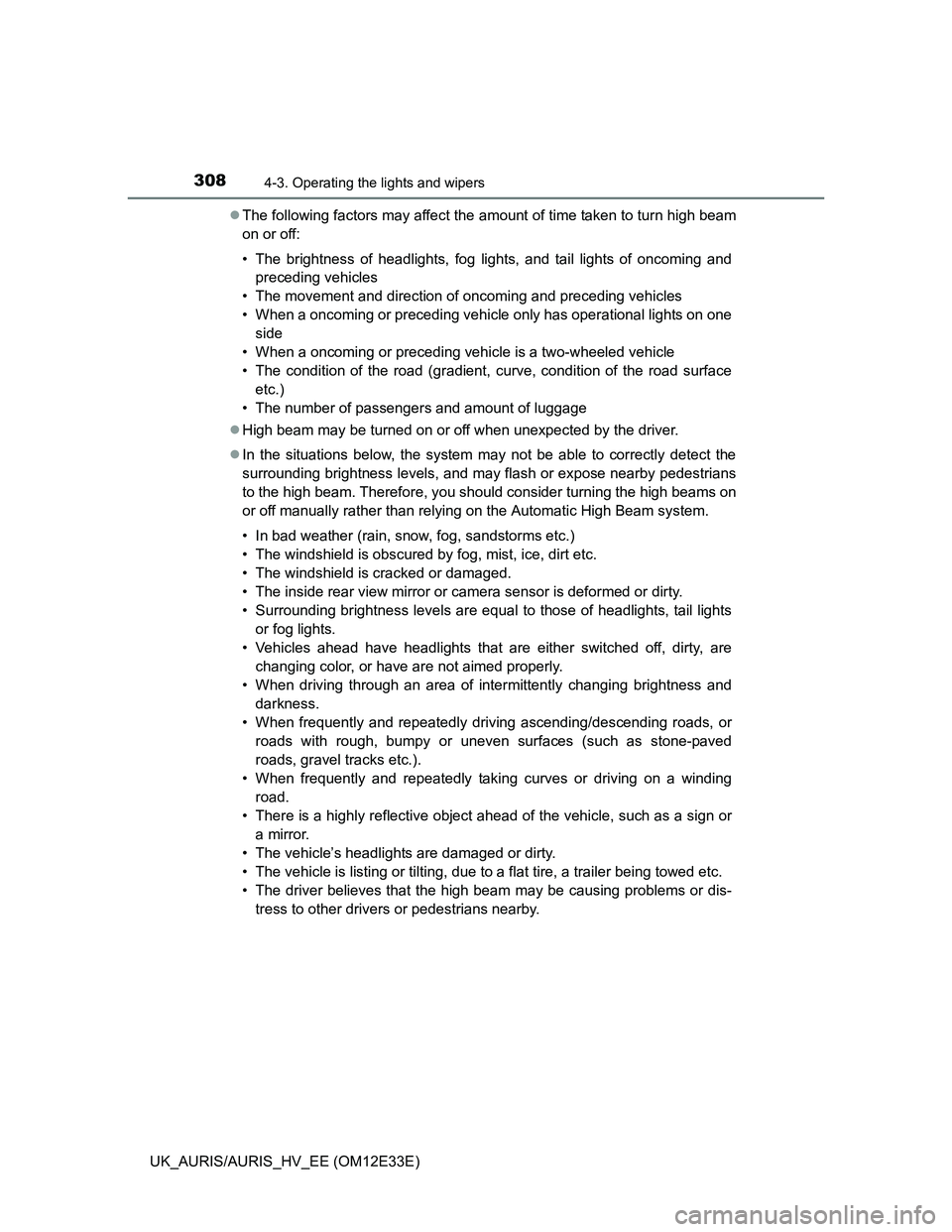
3084-3. Operating the lights and wipers
UK_AURIS/AURIS_HV_EE (OM12E33E)The following factors may affect the amount of time taken to turn high beam
on or off:
• The brightness of headlights, fog lights, and tail lights of oncoming and
preceding vehicles
• The movement and direction of oncoming and preceding vehicles
• When a oncoming or preceding vehicle only has operational lights on one
side
• When a oncoming or preceding vehicle is a two-wheeled vehicle
• The condition of the road (gradient, curve, condition of the road surface
etc.)
• The number of passengers and amount of luggage
High beam may be turned on or off when unexpected by the driver.
In the situations below, the system may not be able to correctly detect the
surrounding brightness levels, and may flash or expose nearby pedestrians
to the high beam. Therefore, you should consider turning the high beams on
or off manually rather than relying on the Automatic High Beam system.
• In bad weather (rain, snow, fog, sandstorms etc.)
• The windshield is obscured by fog, mist, ice, dirt etc.
• The windshield is cracked or damaged.
• The inside rear view mirror or camera sensor is deformed or dirty.
• Surrounding brightness levels are equal to those of headlights, tail lights
or fog lights.
• Vehicles ahead have headlights that are either switched off, dirty, are
changing color, or have are not aimed properly.
• When driving through an area of intermittently changing brightness and
darkness.
• When frequently and repeatedly driving ascending/descending roads, or
roads with rough, bumpy or uneven surfaces (such as stone-paved
roads, gravel tracks etc.).
• When frequently and repeatedly taking curves or driving on a winding
road.
• There is a highly reflective object ahead of the vehicle, such as a sign or
a mirror.
• The vehicle’s headlights are damaged or dirty.
• The vehicle is listing or tilting, due to a flat tire, a trailer being towed etc.
• The driver believes that the high beam may be causing problems or dis-
tress to other drivers or pedestrians nearby.
Page 328 of 750
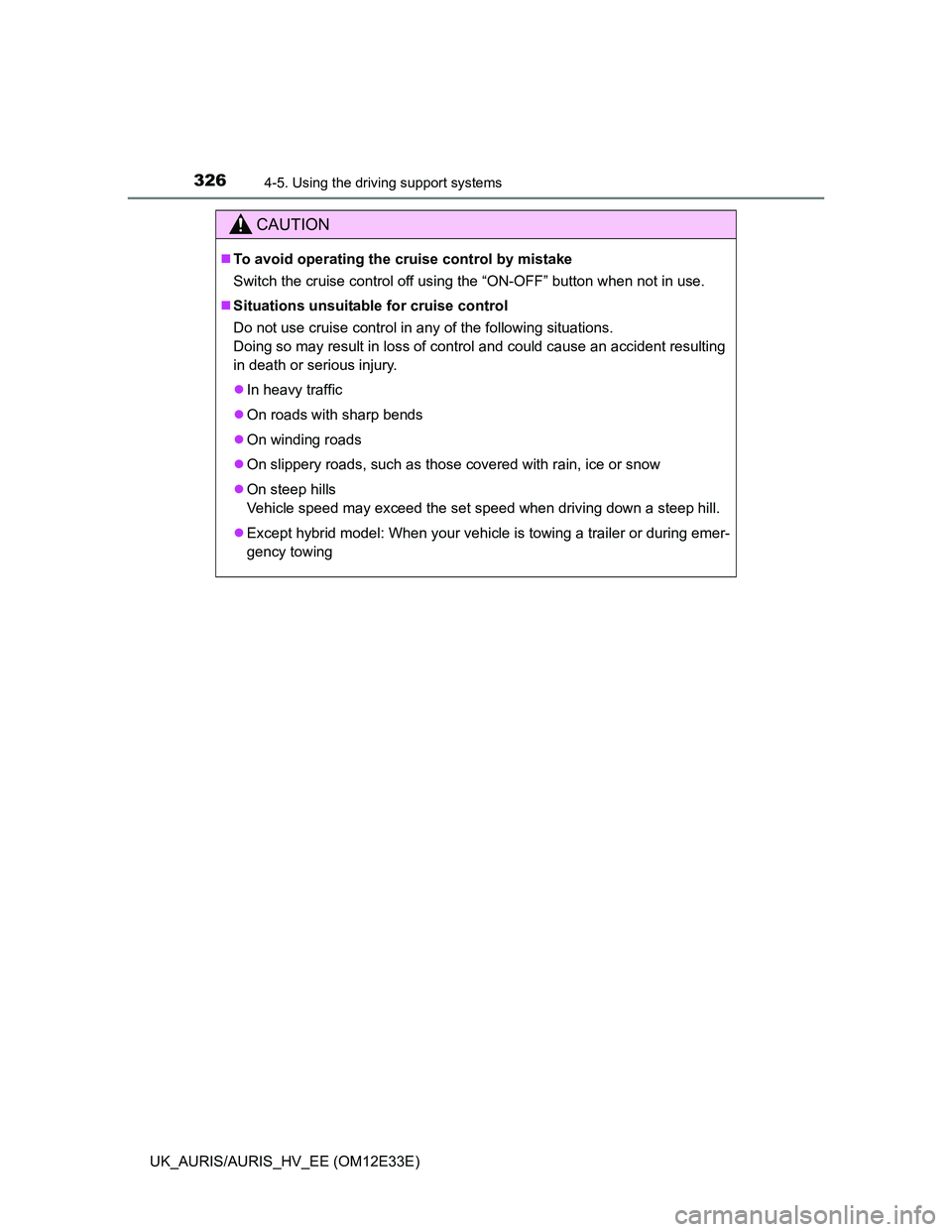
3264-5. Using the driving support systems
UK_AURIS/AURIS_HV_EE (OM12E33E)
CAUTION
To avoid operating the cruise control by mistake
Switch the cruise control off using the “ON-OFF” button when not in use.
Situations unsuitable for cruise control
Do not use cruise control in any of the following situations.
Doing so may result in loss of control and could cause an accident resulting
in death or serious injury.
In heavy traffic
On roads with sharp bends
On winding roads
On slippery roads, such as those covered with rain, ice or snow
On steep hills
Vehicle speed may exceed the set speed when driving down a steep hill.
Except hybrid model: When your vehicle is towing a trailer or during emer-
gency towing
Page 331 of 750
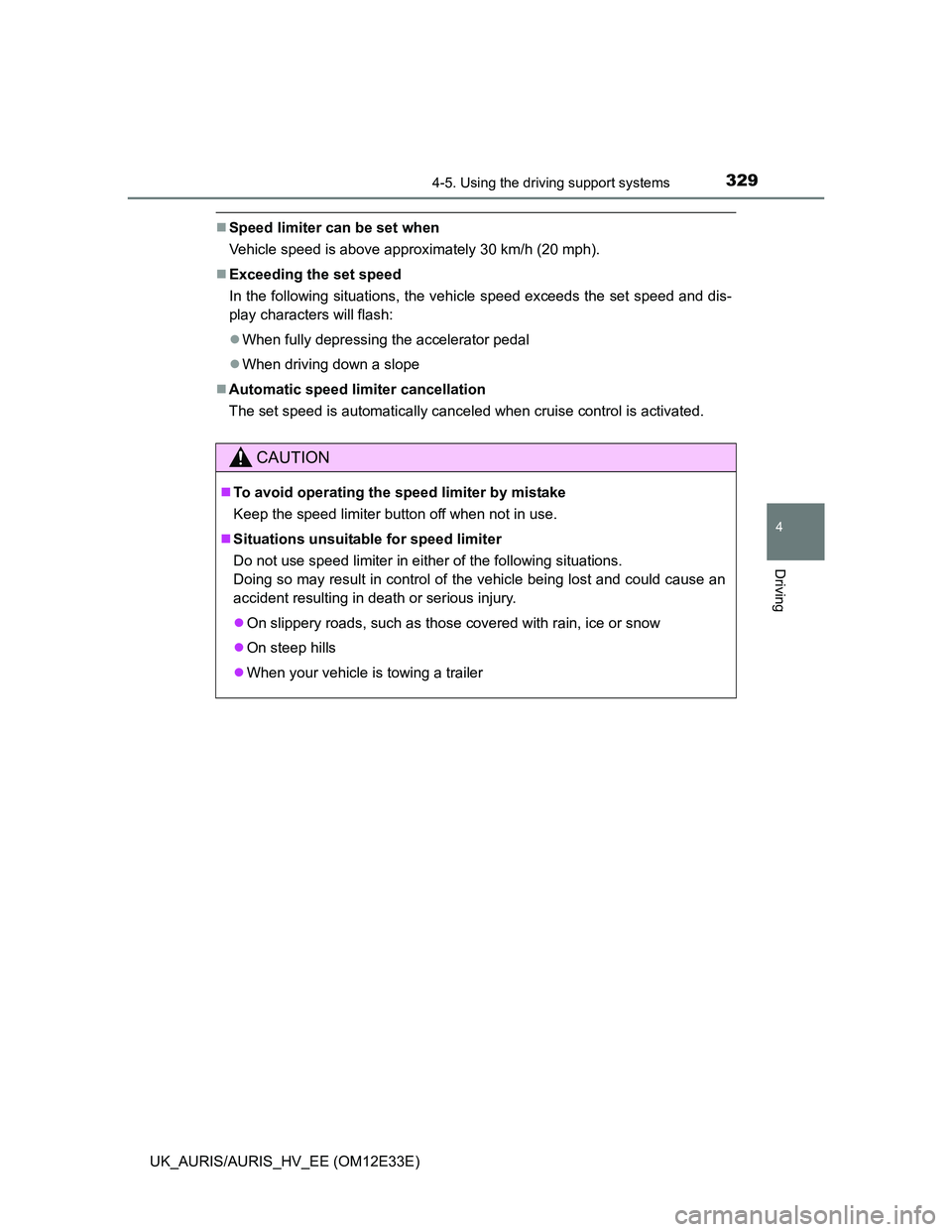
3294-5. Using the driving support systems
UK_AURIS/AURIS_HV_EE (OM12E33E)
4
Driving
Speed limiter can be set when
Vehicle speed is above approximately 30 km/h (20 mph).
Exceeding the set speed
In the following situations, the vehicle speed exceeds the set speed and dis-
play characters will flash:
When fully depressing the accelerator pedal
When driving down a slope
Automatic speed limiter cancellation
The set speed is automatically canceled when cruise control is activated.
CAUTION
To avoid operating the speed limiter by mistake
Keep the speed limiter button off when not in use.
Situations unsuitable for speed limiter
Do not use speed limiter in either of the following situations.
Doing so may result in control of the vehicle being lost and could cause an
accident resulting in death or serious injury.
On slippery roads, such as those covered with rain, ice or snow
On steep hills
When your vehicle is towing a trailer
Page 350 of 750
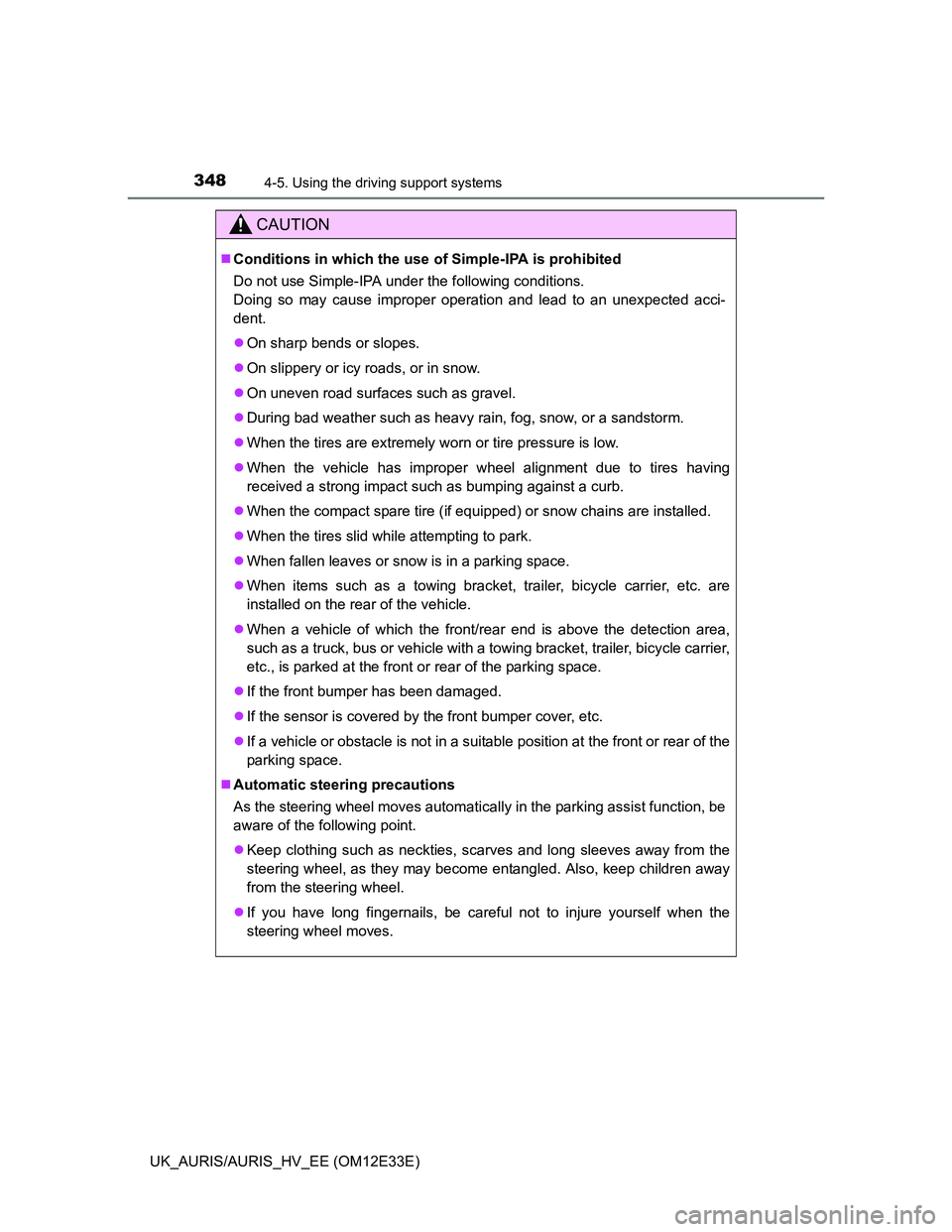
3484-5. Using the driving support systems
UK_AURIS/AURIS_HV_EE (OM12E33E)
CAUTION
Conditions in which the use of Simple-IPA is prohibited
Do not use Simple-IPA under the following conditions.
Doing so may cause improper operation and lead to an unexpected acci-
dent.
On sharp bends or slopes.
On slippery or icy roads, or in snow.
On uneven road surfaces such as gravel.
During bad weather such as heavy rain, fog, snow, or a sandstorm.
When the tires are extremely worn or tire pressure is low.
When the vehicle has improper wheel alignment due to tires having
received a strong impact such as bumping against a curb.
When the compact spare tire (if equipped) or snow chains are installed.
When the tires slid while attempting to park.
When fallen leaves or snow is in a parking space.
When items such as a towing bracket, trailer, bicycle carrier, etc. are
installed on the rear of the vehicle.
When a vehicle of which the front/rear end is above the detection area,
such as a truck, bus or vehicle with a towing bracket, trailer, bicycle carrier,
etc., is parked at the front or rear of the parking space.
If the front bumper has been damaged.
If the sensor is covered by the front bumper cover, etc.
If a vehicle or obstacle is not in a suitable position at the front or rear of the
parking space.
Automatic steering precautions
As the steering wheel moves automatically in the parking assist function, be
aware of the following point.
Keep clothing such as neckties, scarves and long sleeves away from the
steering wheel, as they may become entangled. Also, keep children away
from the steering wheel.
If you have long fingernails, be careful not to injure yourself when the
steering wheel moves.
Page 717 of 750
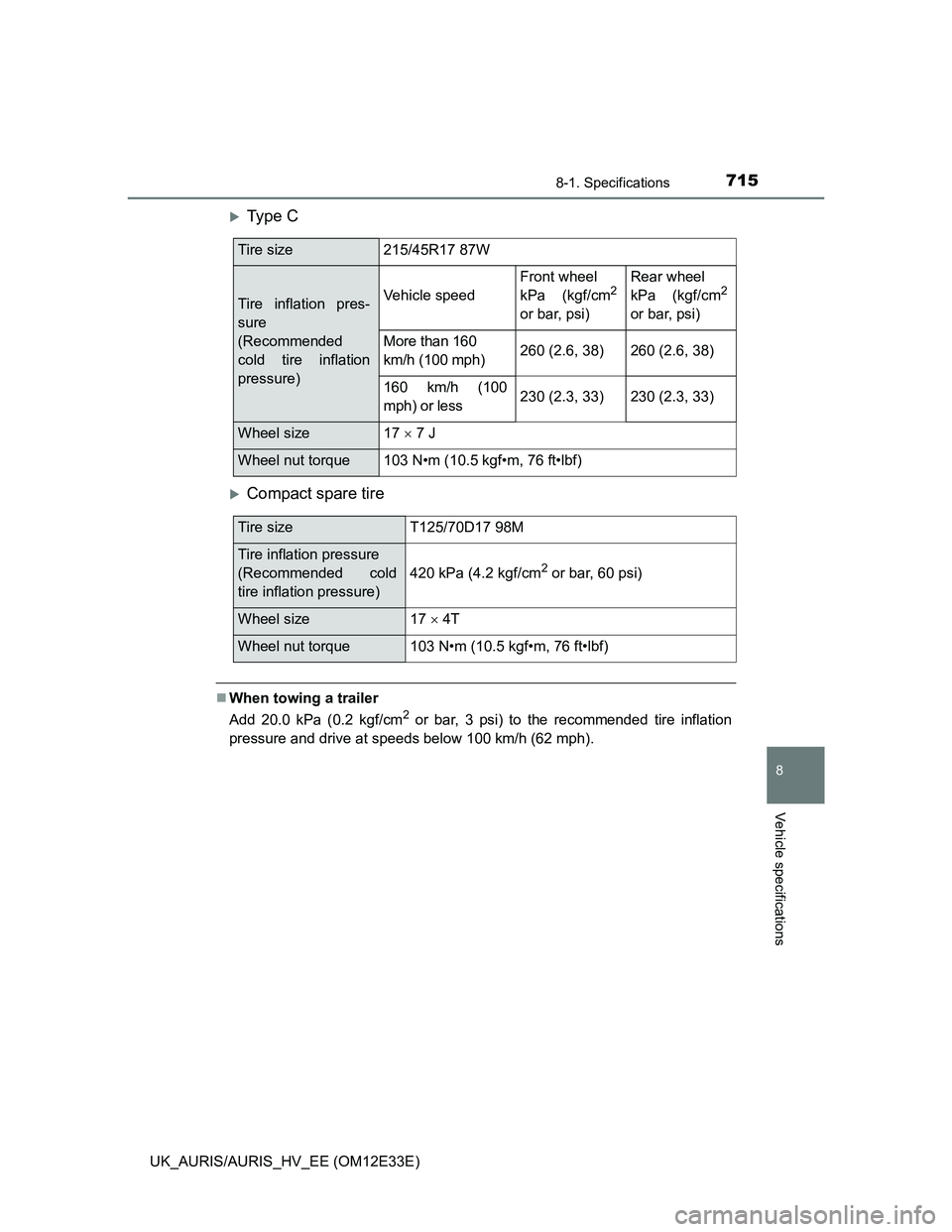
7158-1. Specifications
UK_AURIS/AURIS_HV_EE (OM12E33E)
8
Vehicle specifications
Ty p e C
Compact spare tire
When towing a trailer
Add 20.0 kPa (0.2 kgf/cm
2 or bar, 3 psi) to the recommended tire inflation
pressure and drive at speeds below 100 km/h (62 mph).
Tire size215/45R17 87W
Tire inflation pres-
sure
(Recommended
cold tire inflation
pressure)Vehicle speed
Front wheel
kPa (kgf/cm2
or bar, psi)
Rear wheel
kPa (kgf/cm2
or bar, psi)
More than 160
km/h (100 mph)260 (2.6, 38)260 (2.6, 38)
160 km/h (100
mph) or less230 (2.3, 33)230 (2.3, 33)
Wheel size17 7 J
Wheel nut torque103 N•m (10.5 kgf•m, 76 ft•lbf)
Tire sizeT125/70D17 98M
Tire inflation pressure
(Recommended cold
tire inflation pressure)
420 kPa (4.2 kgf/cm2 or bar, 60 psi)
Wheel size17 4T
Wheel nut torque103 N•m (10.5 kgf•m, 76 ft•lbf)
Page 746 of 750
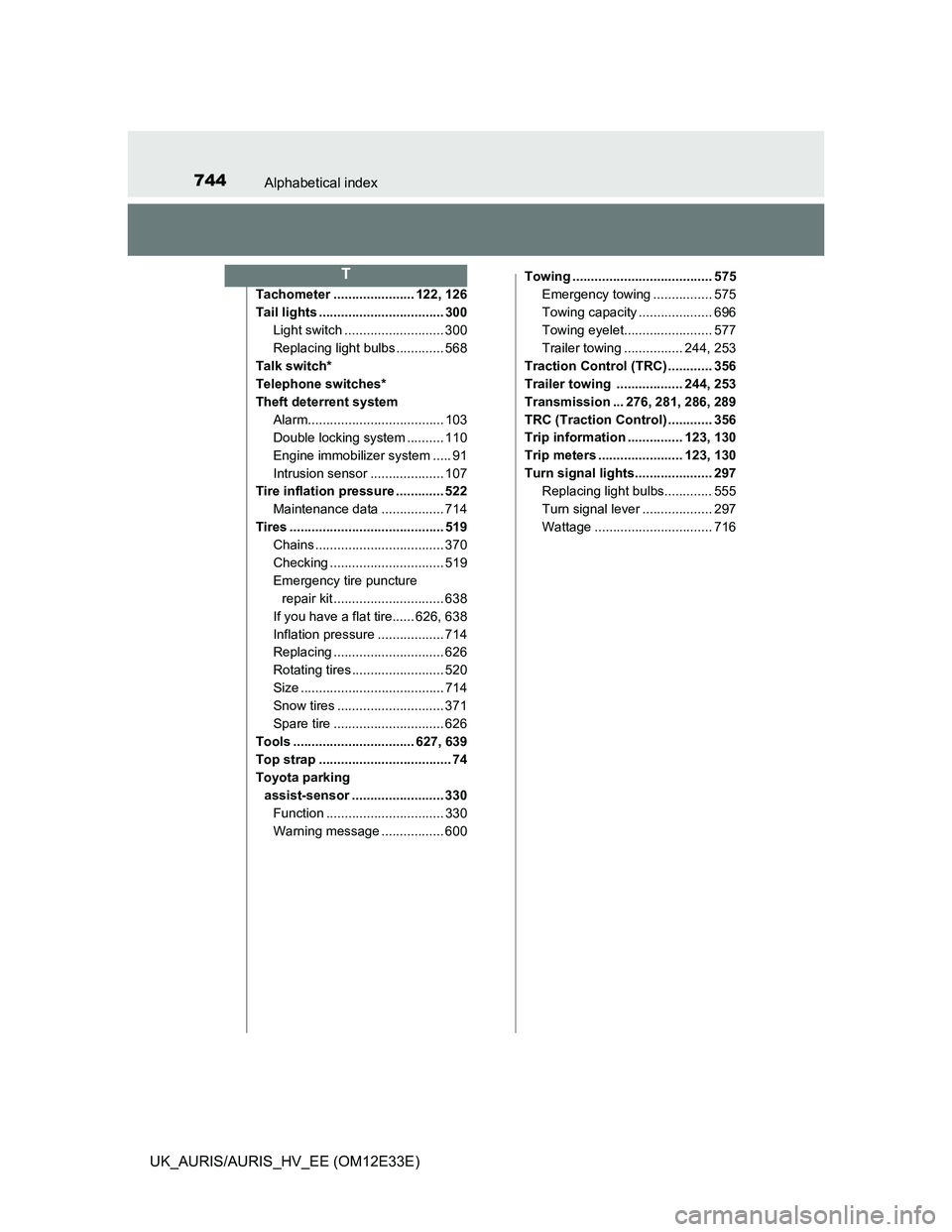
744Alphabetical index
UK_AURIS/AURIS_HV_EE (OM12E33E)
Tachometer ...................... 122, 126
Tail lights .................................. 300
Light switch ........................... 300
Replacing light bulbs ............. 568
Talk switch*
Telephone switches*
Theft deterrent system
Alarm..................................... 103
Double locking system .......... 110
Engine immobilizer system ..... 91
Intrusion sensor .................... 107
Tire inflation pressure ............. 522
Maintenance data ................. 714
Tires .......................................... 519
Chains ................................... 370
Checking ............................... 519
Emergency tire puncture
repair kit .............................. 638
If you have a flat tire...... 626, 638
Inflation pressure .................. 714
Replacing .............................. 626
Rotating tires ......................... 520
Size ....................................... 714
Snow tires ............................. 371
Spare tire .............................. 626
Tools ................................. 627, 639
Top strap .................................... 74
Toyota parking
assist-sensor ......................... 330
Function ................................ 330
Warning message ................. 600Towing ...................................... 575
Emergency towing ................ 575
Towing capacity .................... 696
Towing eyelet........................ 577
Trailer towing ................ 244, 253
Traction Control (TRC) ............ 356
Trailer towing .................. 244, 253
Transmission ... 276, 281, 286, 289
TRC (Traction Control) ............ 356
Trip information ............... 123, 130
Trip meters ....................... 123, 130
Turn signal lights..................... 297
Replacing light bulbs............. 555
Turn signal lever ................... 297
Wattage ................................ 716
T